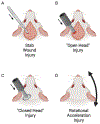The cortical NG2-glia response to traumatic brain injury
- PMID: 36692058
- PMCID: PMC10404390
- DOI: 10.1002/glia.24342
The cortical NG2-glia response to traumatic brain injury
Abstract
Traumatic brain injury (TBI) is a significant worldwide cause of morbidity and mortality. A chronic neurologic disease bearing the moniker of "the silent epidemic," TBI currently has no targeted therapies to ameliorate cellular loss or enhance functional recovery. Compared with those of astrocytes, microglia, and peripheral immune cells, the functions and mechanisms of NG2-glia following TBI are far less understood, despite NG2-glia comprising the largest population of regenerative cells in the mature cortex. Here, we synthesize the results from multiple rodent models of TBI, with a focus on cortical NG2-glia proliferation and lineage potential, and propose future avenues for glia researchers to address this unique cell type in TBI. As the molecular mechanisms that regulate NG2-glia regenerative potential are uncovered, we posit that future therapeutic strategies may exploit cortical NG2-glia to augment local cellular recovery following TBI.
Keywords: NG2-glia; oligodendrocyte precursor cells; traumatic brain injury.
© 2023 Wiley Periodicals LLC.
Conflict of interest statement
POTENTIAL CONFLICTS OF INTERESTS:
Authors report no conflict of interest.
Figures


Similar articles
-
Lack of NG2 exacerbates neurological outcome and modulates glial responses after traumatic brain injury.Glia. 2016 Apr;64(4):507-23. doi: 10.1002/glia.22944. Epub 2015 Dec 6. Glia. 2016. PMID: 26638112
-
Dynamic cell type-specific expression of Nrf2 after traumatic brain injury in mice.Eur J Neurosci. 2019 Jul;50(2):1981-1993. doi: 10.1111/ejn.14399. Epub 2019 Apr 23. Eur J Neurosci. 2019. PMID: 30828870
-
Differential Modulators of NG2-Glia Differentiation into Neurons and Glia and Their Crosstalk.Cell Mol Neurobiol. 2021 Jan;41(1):1-15. doi: 10.1007/s10571-020-00843-0. Epub 2020 Apr 13. Cell Mol Neurobiol. 2021. PMID: 32285247 Free PMC article. Review.
-
NG2-glia crosstalk with microglia in health and disease.CNS Neurosci Ther. 2022 Nov;28(11):1663-1674. doi: 10.1111/cns.13948. Epub 2022 Aug 23. CNS Neurosci Ther. 2022. PMID: 36000202 Free PMC article. Review.
-
Roles of NG2 Glia in Cerebral Small Vessel Disease.Neurosci Bull. 2023 Mar;39(3):519-530. doi: 10.1007/s12264-022-00976-w. Epub 2022 Nov 18. Neurosci Bull. 2023. PMID: 36401147 Free PMC article. Review.
Cited by
-
Microvascularization of the Vocal Folds: Molecular Architecture, Functional Insights, and Personalized Research Perspectives.J Pers Med. 2025 Jul 7;15(7):293. doi: 10.3390/jpm15070293. J Pers Med. 2025. PMID: 40710410 Free PMC article. Review.
-
Astrocytes, reactive astrogliosis, and glial scar formation in traumatic brain injury.Neural Regen Res. 2025 Apr 1;20(4):973-989. doi: 10.4103/NRR.NRR-D-23-02091. Epub 2024 May 17. Neural Regen Res. 2025. PMID: 38989932 Free PMC article.
References
Publication types
MeSH terms
Substances
Grants and funding
LinkOut - more resources
Full Text Sources
Medical
Research Materials

